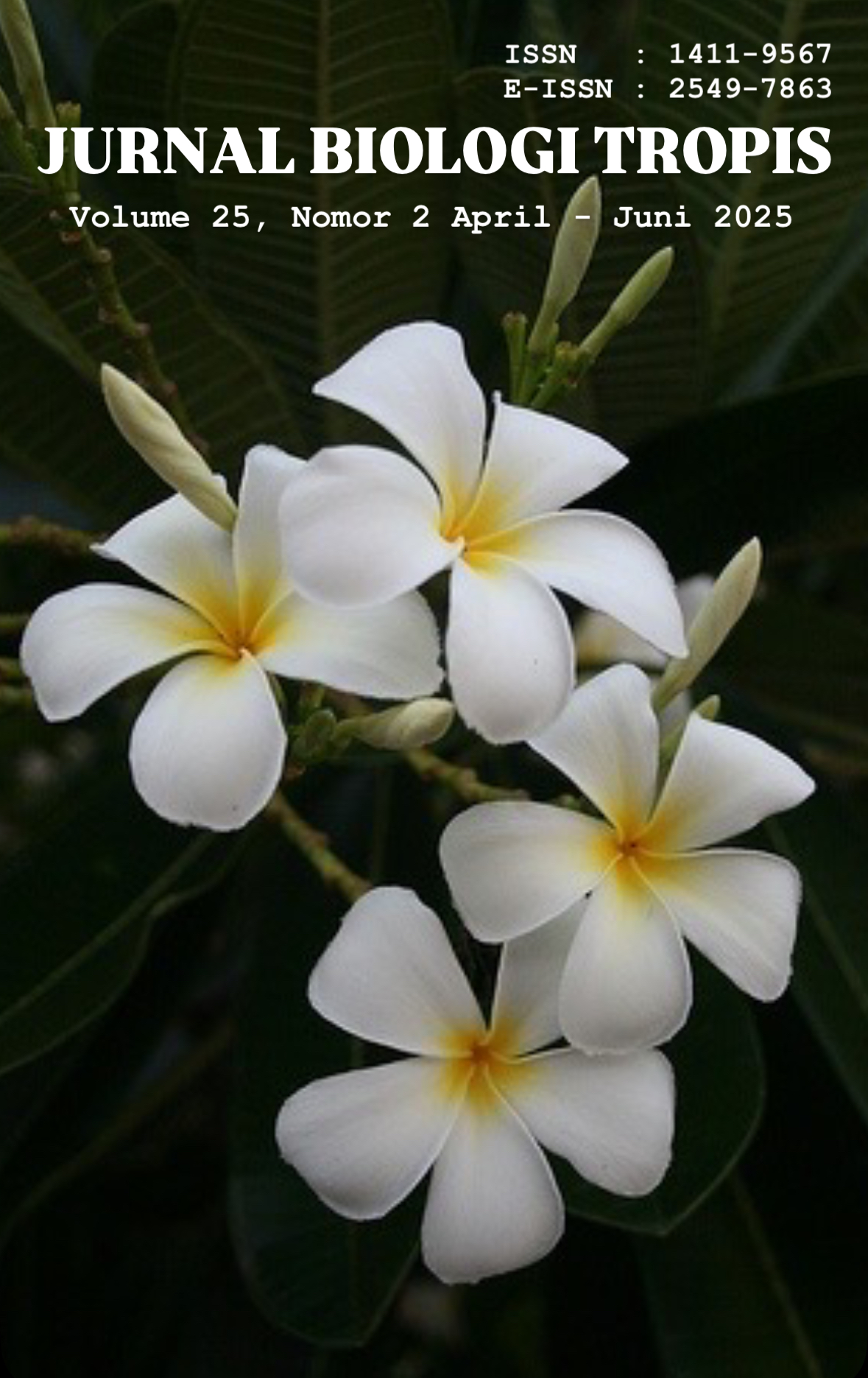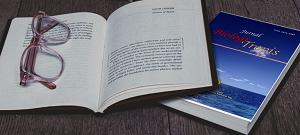The Viability of Indigenous Rhizosphere Fungi of Kirinyuh (Chromolaena odorata) as a Biofungicide for Controlling Anthracnose in Red Chili (Capsicum annuum L.)
Authors
Aji Aji , Roni Maulana Sidiq , Gina Sonia Agustin , Serly Marsita Sari , Annisa Hamdayani , Gilang Vaza BenatarDOI:
10.29303/jbt.v25i2.8576Published:
2025-04-22Issue:
Vol. 25 No. 2 (2025): April-JuniKeywords:
Anthracnose, colletotrichum, Rhizosphere, Kirinyuh.Articles
Downloads
How to Cite
Downloads
Metrics
Abstract
Anthracnose disease caused by Colletotrichum spp. has reduced red chili production in Indonesia, thus requiring control measures that can suppress anthracnose in a more environmentally friendly manner. This research aims to explore the potential of rhizosphere fungi from kirinyuh as a biological agent in controlling anthracnose disease in red chili peppers. (Capsicum annuum L.). Isolates found in the rhizosphere of kirinyuh were identified and then tested for hypersensitivity, in vitro, and in vivo. Eleven rhizosphere fungal isolates from kirinyuh were suspected to belong to the genera Penicillium, Blastomyces, Sepedonium, Aspergillus, Tricladium, and Rhizoctonia, and did not show pathogenicity traits on plants based on hypersensitivity tests. The results of in vitro tests show that the isolate with code CRKF can suppress the growth of Colletotrichum by up to 46%. Meanwhile, in in vivo tests, the CRKA isolate (Penicillium) was able to reduce the intensity of attacks by 13%, the CRKH isolate effectively reduced fruit shrinkage, and the CRKI isolate was proven to slow down the incubation period by up to 4 HSI.
References
Adityawarman, A., Mahyarudin, M. & Effiana, E. (2019). Isolasi, Identifikasi dan Aktivitas Antibakteri Bakteri Endofit Daun Pegagan (Centella asiatica L.) terhadap Escherichia coli. Jurnal Cerebellum, 5(4B), pp.1569-1582.
Anggraeni, D.N. and Usman, M., (2015). Uji Aktivitas dan Identifikasi Jamur Rhizosfer pada Tanah Perakaran Tanaman Pisang (Musa paradisiaca) Terhadap Jamur Fusarium. BIOLINK (Jurnal Biologi Lingkungan Industri Kesehatan), 1(2), pp.89-98.
Badan Pusat Statistik Provinsi Jambi. (2022). Produksi Sayuran dan Buah-Buahan Provinsi Jambi 2021. Jambi: Badan Pusat Statistik. https://jambi.bps.go.id/publication/2023/11/07/e8aeb331b303dadab0f6c335/produksi-sayuran-dan-buah-buahan-provinsi-jambi-2022.html. Diakses tanggal 9 Januari 2024.
Baxter, C. E., & Wong, S. C. (2019). Enzymatic degradation of plant cell walls by fungal pathogens. Molecular Plant Pathology, 20(6), 877-891.
Heirina, A., Rozirwan, R., & Hendri, M. (2020). Isolasi dan aktivitas antibakteri jamur endofit pada mangrove Sonneratia alba dari Tanjung Carat Kabupaten Banyuasin Sumatera Selatan. Jurnal Penelitian Sains, 22(1), 16-24.
Khulillah, I. N., Sastrahidayat, I. R., & Sektiono, A. W. (2020). Isolasi dan uji antagonis jamur filoplen terhadap antraknosa (Colletotrichum sp.) pada tanaman Anthurium bunga (Anthurium andraeanum). Jurnal HPT (Hama Penyakit Tumbuhan), 8(1), 16-21.
Mirsam, H., Munif, A., Rahim, Y.F., Rosya, A. and Rusae, A. (2016). Potensi bakteri antagonis Dari tumbuhan kirinyuh sebagai agens hayati dan penginduksi pertumbuhan tanaman. Prosiding, 2(1).
Mirsam, H., Rosya, A., Fauziah Rahim, Y., Rusae, A. dan Munif, A. (2015). Eksplorasi cendawan antagonis Dari tanaman kirinyuh (Chromolaena odorata L.) sebagai agens hayati dan pemacu pertumbuhan. PROSIDING SEMINAR NASIONAL PERLINDUNGAN TANAMAN II. 13 November 2014, Bogor, Indonesia. pp. 167 – 175.
Muhammad, S. S., Avianto, Y., Anindita, N. S., & Nugraheni, I. A. (2023). Potensi bakteri endofit dari tanaman cabai dan batang ketimun sebagai agen biokontrol terhadap jamur Fusarium sp. In Prosiding Seminar Nasional Penelitian dan Pengabdian Kepada Masyarakat LPPM Universitas' Aisyiyah Yogyakarta. Vol. 1, pp. 338-345.
Nurbailis, Martinus, dan Naipinta, R. (2017). Kesintasan Beberapa Jamur Antagonis pada Buah Cabai dan Potensinya dalam Menekan Penyakit Antraknosa yang disebabkan oleh Colletotrichum gloeosporioides. Jurnal Hama dan Penyakit Tumbuhan Tropika, 17(2), 162-169.
Nisa, C. (2018). Pengujian formulasi Trichoderma sp. terhadap pencegahan patogen Fusarium oxysporum penyebab penyakit layu pada cabai rawit (Capsicum frutescens) secara in vivo (Doctoral dissertation, Universitas Islam Negeri Maulana Malik Ibrahim).
Noerfitryani, N., & Hamzah, H. 2018. Inventarisasi Jenis–Jenis Cendawan Pada Rhizosfer Pertanaman Padi. Jurnal Galung Tropika, 7(1), 11-21.
Prayudyaningsih, R. and Nursyamsi & Sari, R. (2015). Mikroorganisme tanah bermanfaat pada rhizosfer tanaman umbi di bawah tegakan hutan rakyat Sulawesi Selatan. Pros Sem Nas Masy Biodiv Indon, 1(4), pp.954-959.
Sakerebau, D. R. M., & Wahyu, B. P. W. S. P. (2013). Minyak nilam sebagai biofungisida untuk pengendalian penyakit antraknosa cabai. Jurnal Fitopatologi Indonesia. 9(3), 84-84.
Sandy, Y. A., Djauhari, S., & Sektiono, A. W. (2015). Identifikasi molekuler jamur antagonis Trichoderma harzianum diisolasi dari tanah pertanian di Malang, Jawa Timur. Jurnal HPT (Hama Penyakit Tumbuhan), 3(3), 1-8.
Samah, E. S. (2019). Capability of Cellulolytic Degradation (BSD) Bacteria (CDB) to Remodel Organic Waste into Compost. Dentika: Dental Journal, 6(3), 490-499.
Saxena, A., Mishra, S., Ray, S., Raghuwanshi, R., & Singh, H. B. (2020). Differential reprogramming of defense network in Capsicum annum L. plants against Colletotrichum truncatum infection by phyllospheric and rhizospheric Trichoderma strains. Journal of plant growth regulation. 39, 751-763.
Seema, M., & Devaki, N. S. (2012). In vitro evaluation of biological control agents against Rhizoctonia solani. Journal of Agricultural Technology. 8(1), 233-240.
Sine, Y. and Soetarto, E.S. (2018). Isolasi dan identifikasi kapang Rhizopus pada tempe gude (Cajanus cajan L.). Jurnal Savana Cendana, 3(04), pp.67-68.
Suanda, I. W. (2019). Karakterisasi morfologis Trichoderma sp. isolat jb dan daya hambatnya terhadap jamur Fusarium sp. penyebab penyakit layu dan jamur akar putih pada beberapa tanaman. Jurnal Widya Biologi, 10(02), 99-112.
Supriati, L., & Djaya, A. A. (2016). Pengendalian Penyakit Antraknosa Pada Tanaman Cabai Merah Menggunakan Agen Hayati Trichoderma Harzianum dan Actinomycetes. Jurnal Agripeat, 17(01), 20-26.
Sutarini, N.L.W., Sumiartha, I.K., Suniti, N.W., Sudiarta, I.P., Wirya, G.N.A.S. dan Utama, M.S. (2015). Pengendalian Penyakit Layu Fusarium pada Tanaman Cabai Besar (Capsicum annuum L.) dengan Kompos dan Pupuk Kandang yang Dikombinasikan dengan Trichoderma sp. di Rumah Kaca. E-Jurnal Agroekoteknologi Tropika. 4(2):135-144.
Syabana, M.A., Saylendra, A. and Ramdhani, D. (2015). Aktivitas Anti Cendawan Ekstrak Daun Sereh Wangi (Cymbopogon Nardus L.) Terhadap Colletotrichum Spp. Penyebab Penyakit Antraknosa Pada Buah Cabai (Capsicum Annum L.) Secara In vitro Dan In vivo. Jurnal Agrologia, 4(1), P.288706.
Tamara, D. E. (2022). Pengaruh Ekstrak Daun Bandotan (Ageratum Conizoides L.) Terhadap Pertumbuhan Fusarium Oxysporum Pada Tanaman Cabai Merah Besar (Capsicum Annuum L.).
Tasrif, A., Sulistyowati, D., Adirianto, B., Krisnawati, E., & Sugihati, D. (2024). Potensi Cendawan Antagonis Trichoderma Viride Isolat Bogor sebagai Agensi Pengendalian Hayati Penyakit Antraknosa Tanaman Cabai Merah. Jurnal Agroekoteknologi dan Agribisnis, 8(1), 69-80.
Wahdania, I., Asrul, & Rosmini. (2016). Uji daya hambat Aspergillus niger pada berbagai bahan pembawa terhadap Phytopththora palmivora penyebab busuk buah kakao (Theobroma cacao L.). Jurnal Agrotekbis, 4(5), 521–529
Yanti, Y., Astuti, F. F., Habazar, T., & Nasution, C. R. (2017). Screening of rhizobacteria from rhizosphere of healthy chili to control bacterial wilt disease and to promote growth and yield of chili. Biodiversitas Journal of Biological Diversity, 18(1).
License
Copyright (c) 2025 Aji Aji, Roni Maulana Sidiq, Serly Marsita Sari, Gina Sonia Agustin; Gilang Vaza Benatar

This work is licensed under a Creative Commons Attribution 4.0 International License.

Jurnal Biologi Tropis is licensed under a Creative Commons Attribution 4.0 International License.
The copyright of the received article shall be assigned to the author as the owner of the paper. The intended copyright includes the right to publish the article in various forms (including reprints). The journal maintains the publishing rights to the published articles.
Authors are permitted to disseminate published articles by sharing the link/DOI of the article at the journal. Authors are allowed to use their articles for any legal purposes deemed necessary without written permission from the journal with an acknowledgment of initial publication to this journal.


























